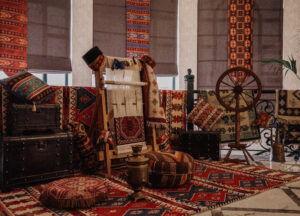The essence of “handmade” is multifaceted, embracing a multitude of methods of creation.
Think of an artisan who raises his own sheep, harvests and spins their wool and then knits uniquely designed sweaters. The entire process, from the materials used to the final product, is the result of the work of this artist, giving him total control over his creation. It’s definitely amazing! On KOMbelle, you’ll find people with equally fascinating stories. However, the notion of “handmade” goes beyond these unique stories. By establishing the criteria for “handmade” products on KOMbelle, we seek a balance between completely “handmade” and exclusively industrial production. The numerous questions we receive about the products accepted have prompted us to clarify two fundamental points concerning the concept of “handmade” on KOMbelle.
The criteria for “handmade” products as defined in the DOs & DON’Ts of the site are as follows: “On KOMbelle, the term “handmade” includes both “hand-assembled” and “modified” objects. by hand “. » We recognize that artists and artisans have boundless creativity. They master a variety of skills and hold a unique aesthetic. Our intention is not to restrict creativity on KOMbelle. Our community welcomes all forms of artistic and technical expression, even if the story of each creator, similar to that of the artisan, the sheep and the sweater, is in itself exceptional.
We do not require every seller on KOMbelle to oversee the entire creative process, from raw material to finished product. Often, a crafter starts with materials created by others, such as beads, fabrics, or other supplies. Combining A with B to get product C is one of the simplest ways to create something new. This type of hand assembly is accepted in the “Handmade” category on KOMbelle. These manually assembled products vary from a simple fusion of two elements to more elaborate products requiring different manufacturing stages and various techniques. Some artisans select rare or innovative materials to design truly unique products, while others use more trendy elements, creating products that are sometimes similar between different boutiques.
To be more explicit, when we talk about “hand assembly” on KOMbelle, we are not referring to pre-assembled kits, where all parts are provided for assembly. For example, if someone buys an IKEA bookcase that comes flat packed, with all the pre-cut parts and hardware needed to assemble it, and assembles that piece of furniture according to the instructions, that bookcase cannot be categorized as “made-made.” main » on KOMbelle. Likewise, bringing together different commercial products to redistribute them in a gift box is not considered “handmade assembly” by KOMbelle.
The notion of “handmade” also includes transformation. “Handmade transformation” of a product means modifying an object in a way that reflects the creativity of the artist. Beautification represents a form of transformation of the appearance of an object. Painting, printing, dyeing, embroidering, decoupage, and adding decorations are classic examples of embellishment. Transformation also includes changing the shape or structure of an object, through engraving, merging two elements or even deconstruction and reconstruction.
The amazing diversity of handmade products from our community continues to inspire us. We hope that these clarifications and examples will contribute to a better understanding of our vision of “handmade” on KOMbelle, and will help you define your own conception of creativity. When reporting products that you believe do not meet the definition of “handmade”, please keep this explanation in mind. If you have any questions regarding the site criteria, do not hesitate to contact us. Our team is now better prepared than ever to answer your questions. Stay tuned for more information in our next Marketplace Integrity update. We invite you to participate in the discussion on this topic on our forum (in English).









